I was really looking forward to visiting the El Tatio Geysers in the Atacama Desert!
Despite having lived and travelled in South America, Chile was a country that I had only ever flown through, and then a few years ago Sam showed me some pictures from his trip to San Pedro de Atacama and I was sold – I wanted to visit this arid landscape dotted with volcanoes and lagoons. It looked out of this world!
When we finally reached the town of San Pedro on this trip, we were overwhelmed with the number of excursions available, but we ended up choosing the sunrise tour of El Tatio geysers complete with a pancake breakfast! It turned out to be a great experience and now we’re going to share it with you.
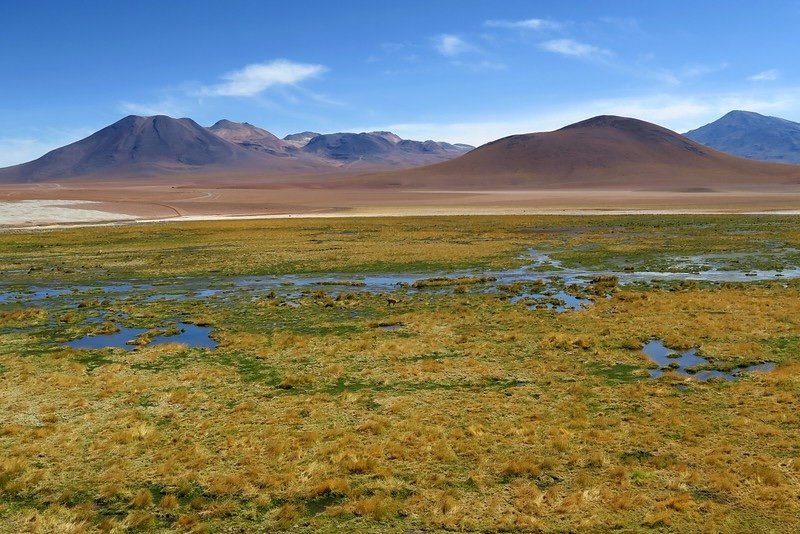
Visiting El Tatio Geysers
El Tatio is a geyser field that sits at 4,320 meters above sea level and it has over 80 geysers scattered around the area. That makes El Tatio the highest geyser field in the entire world, as well as the third largest based on the number of active geysers.
Our morning started bright and early (a little too early if you ask me), with a 5:00 a.m pick-up. I couldn’t tell you much about the drive out to the geyser field since I was napping in the truck, but then again it was pitch black out so I doubt I missed much.
What I can tell you is that on the drive over we had individual fleece blankets to keep warm, and I was more than happy to be able to extend my sleep time by a few more hours. By the time we pulled into the park, the sun was just starting to peek over the mountains and we had a pretty cool scene before us.
So why were we up so early? Well, the reason for the early visit to El Tatio has to do with temperature. If you go there in the early morning just shortly after sunrise, the temperature usually hovers around the freezing mark, while the heat rising from some of the fumaroles can reach 85° Celsius. That’s when you get really cool towers of steam rising up into the sky, creating a scene that looks a little bit like an inferno.
We had some time to walk around the geysers and soak in this other worldly scene. It was cool seeing giant bursts of water shooting into the air, bubbles gurgling just below the surface of some of the lagoons, and little clouds of steam rising from open pockets in the earth – the latter was a nice way to warm up our frozen fingers.
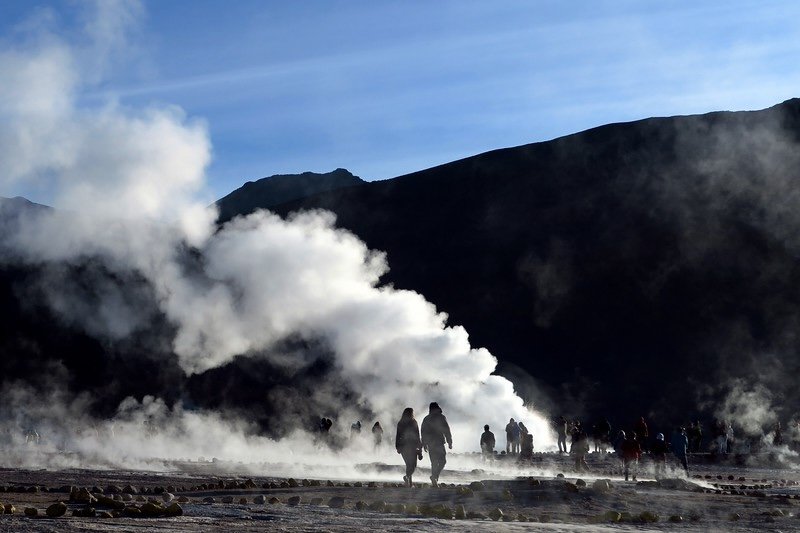
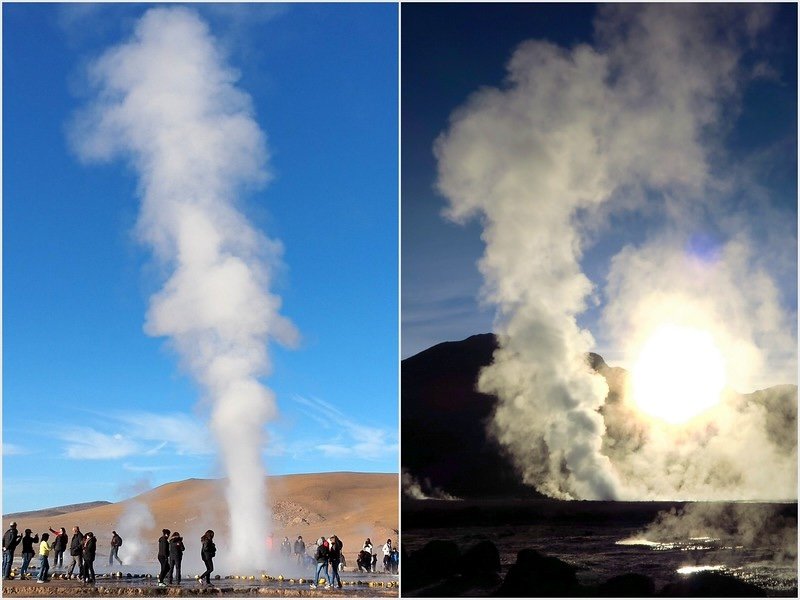

A dip in the Hot Springs
After walking around the geyser field and having fun taking some Dantesque photos, we headed over to the nearby hot springs, where we had the chance to enjoy a hot soak while breakfast was made.
I’d like to say I hopped right in, but I was still wrapped up in my blanket thawing from the early morning walk, and there was no way I was changing into a bikini and braving the cold for those few brief seconds while I tip-toed from the change rooms to the hot springs.
So I sat it out and watched Sam go in instead. Can you spot him in the picture? It’s like Where’s Waldo.
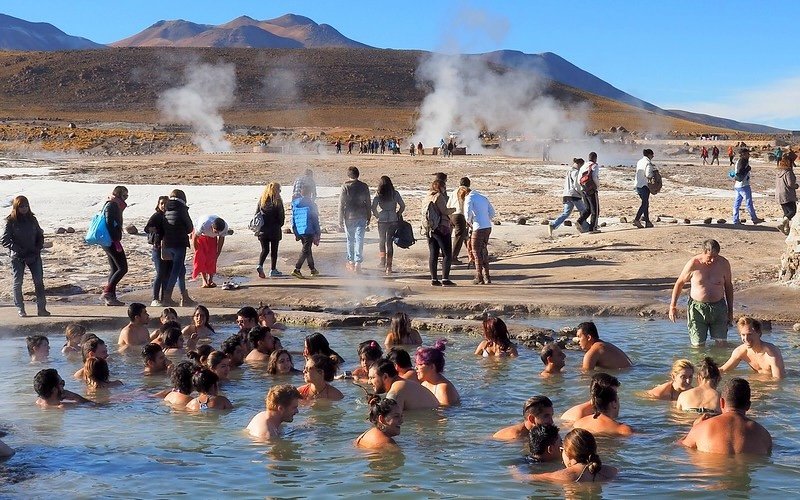
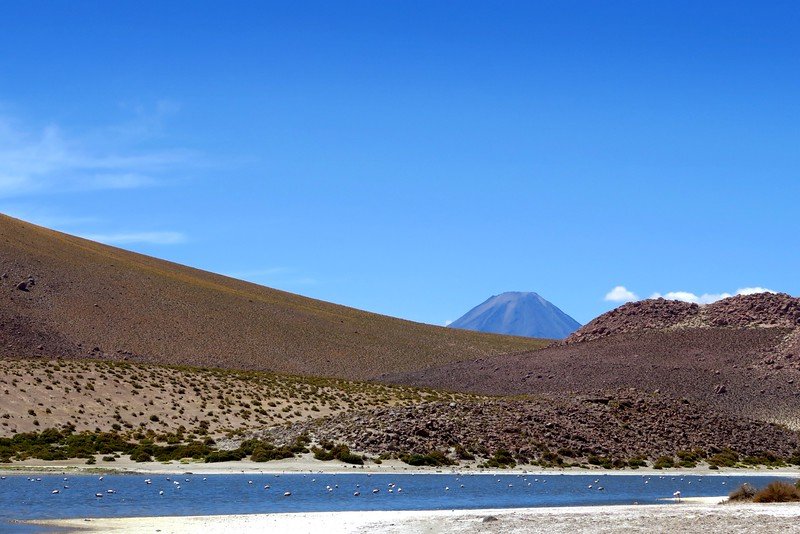
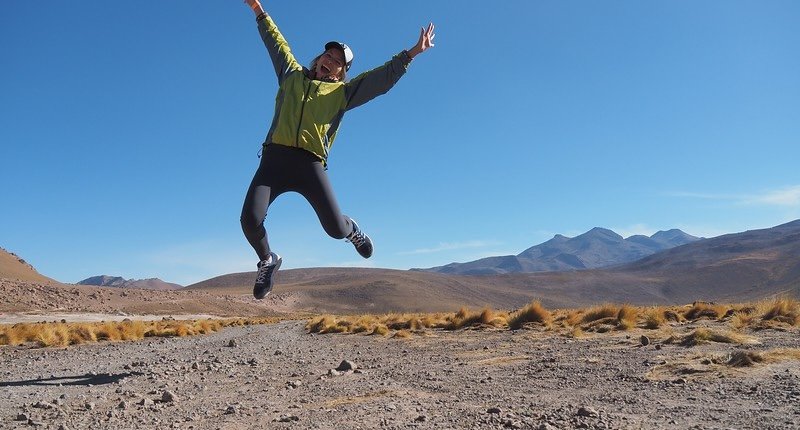
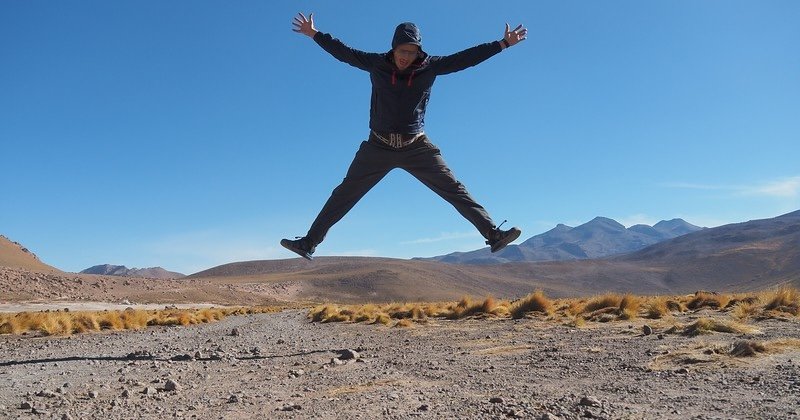
Breakfast of champions
And now for one of the highlights: breakfast!
I have to say, our breakfast with Grado 10 was the best of any other tour out there. While other groups had little coffee stations with a few rolls of bread and cookies, our driver-turned-chef and guide-turned-gourmand pulled out all the stops.
Between the two of them they managed to cook up pancakes and grilled ham and cheese sandwiches in the middle of the altiplano, and they didn’t just serve one round, the food kept coming. They also had pound cake, giant bowls of dulce de leche to spread out on just about everything on the table, and lots of juice, coffee and tea. I was a very happy girl! So happy in fact that I forgot to photograph our delicious breakfast because I was too busy eating.
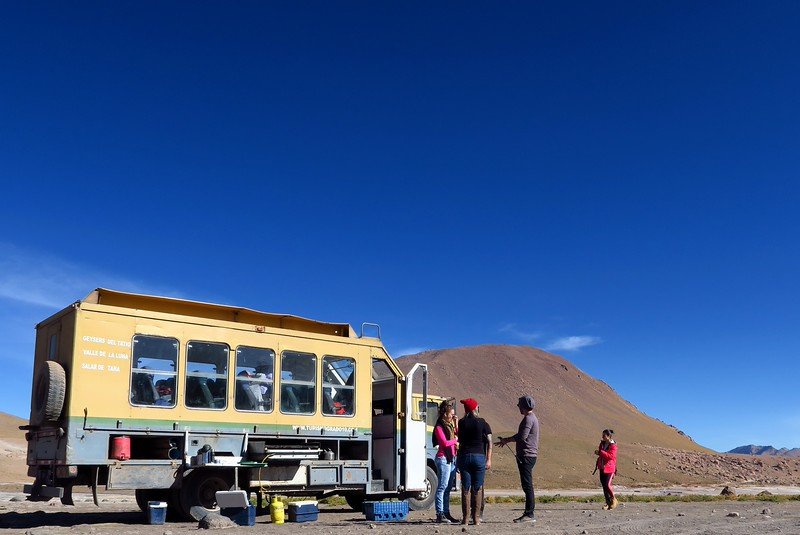
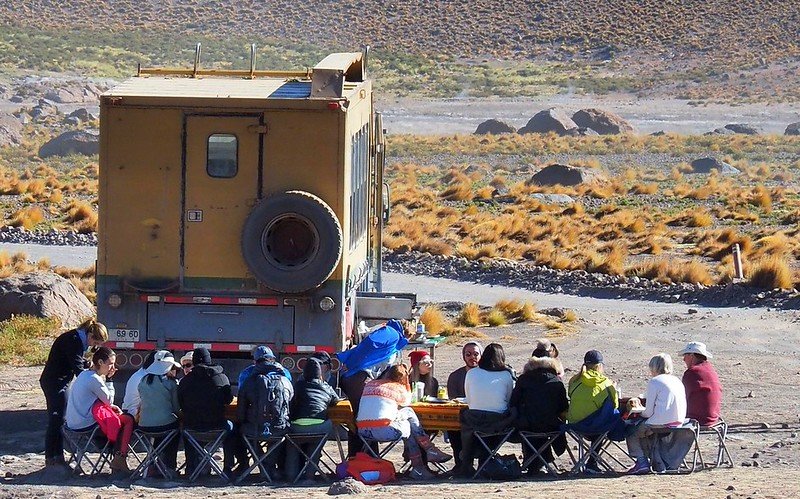
Soaking in the views
After breakfast we packed up the truck and made a few scenic stops along the way. One of them was this green canyon. There’s a trickle of a river that runs through this dry gorge and apparently that’s enough for this little oasis to exist. Once we drove further down the valley and got closer to the base of the canyon we were able to see just how lush it is and how much wildlife it holds.
From there we made another stop at Bado Putano, which is a wetland where lots of guanaco roam, and we also had the Putana Volcano towering in the distance.
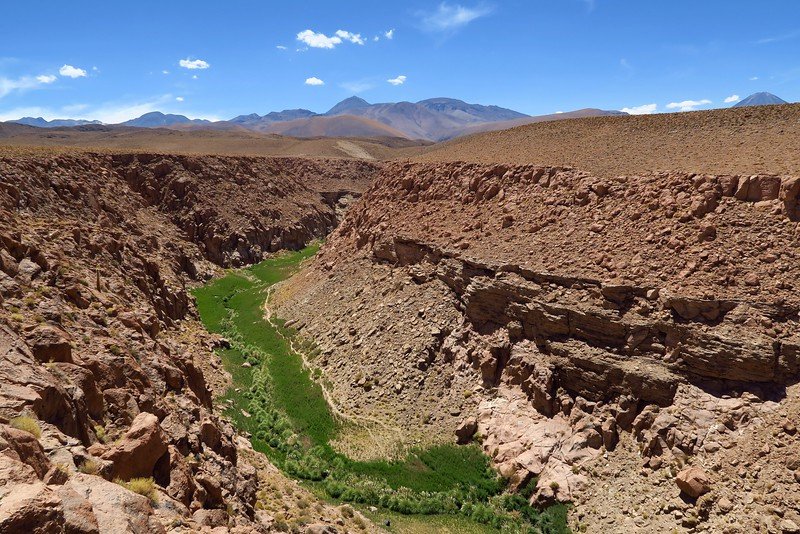
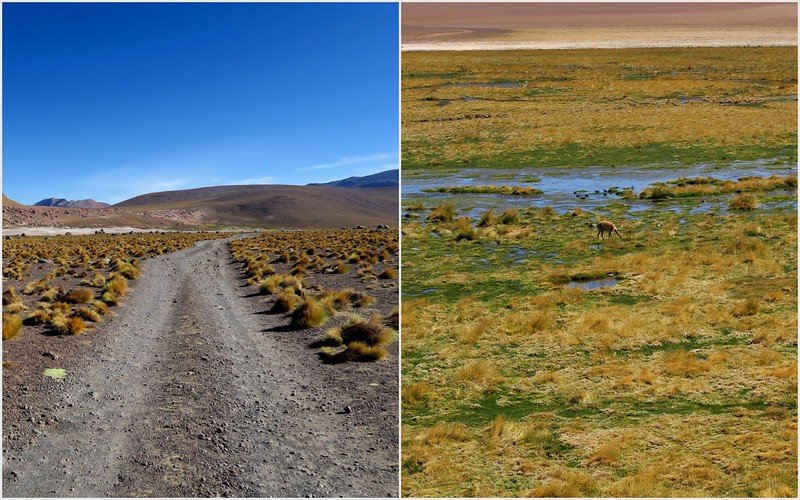
A visit to Machuca
Our last stop of the day was the village of Machuca. The village is divided into two parts: the ruins which are over 1000 years old and the newer area which still adheres to traditional construction.
We had some free time to explore, so I walked up to the church for some nice panoramic views of the town while others snacked on llama skewers (pretty tasty, but I was still full from breakfast).
The village is quite small, has one street, and holds no more than 20 buildings, so you’ll easily cover it with a 30 minute visit.

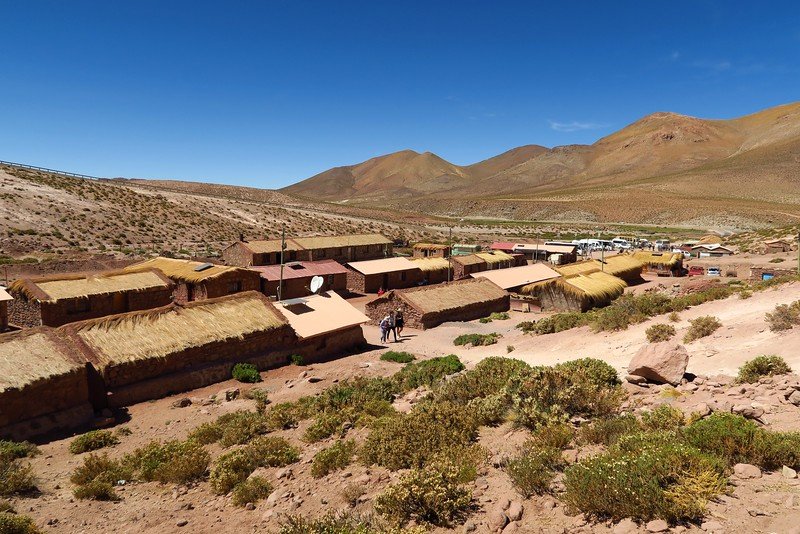
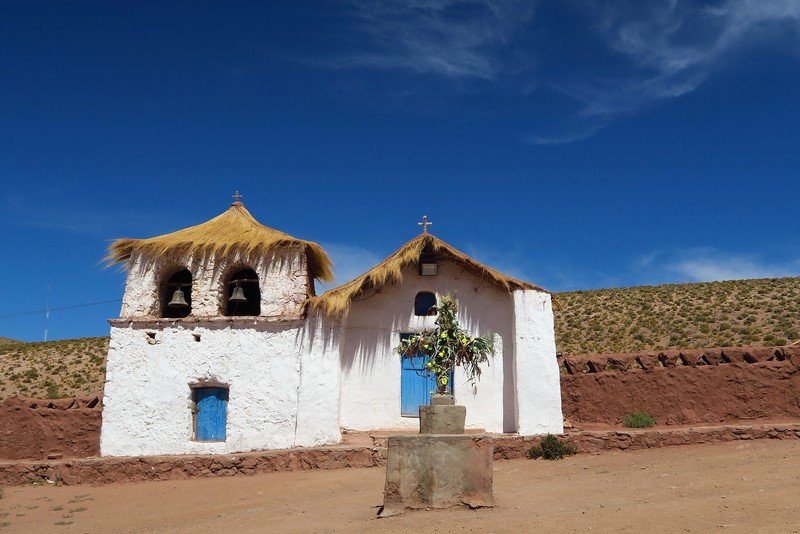
And then it was time to drive back to San Pedro. By the time we hopped back in the truck it was past noon and everyone had already peeled off all the warm layers they had been sporting that morning. It’s fascinating how quickly the temperatures in the desert can change! Now here’s a little video Sam and I made on the trip:
Tips for visiting El Tatio Geysers at sunrise:
- Wear your warmest layers. Mornings in the town of San Pedro aren’t that cold during the summer months, but don’t let that fool you; El Tatio will be freezing. I wore leggings, an alpaca sweater, a windbreaker, and I borrowed a fleece blanket from the truck, and I was still cold.
- Pack a swimsuit and a towel. If you’d like to go for a dip in the hot springs (we got about 45 minutes there), definitely pack a suit and a towel. There are dressing rooms on site, but don’t expect towel rentals.
- Bring lots of water. It’s easy to underestimate just how much water you’ll be guzzling in the desert. Our tour guide recommended bringing at least a 1 Litre bottle, and you’ll easily get through that in half a day.
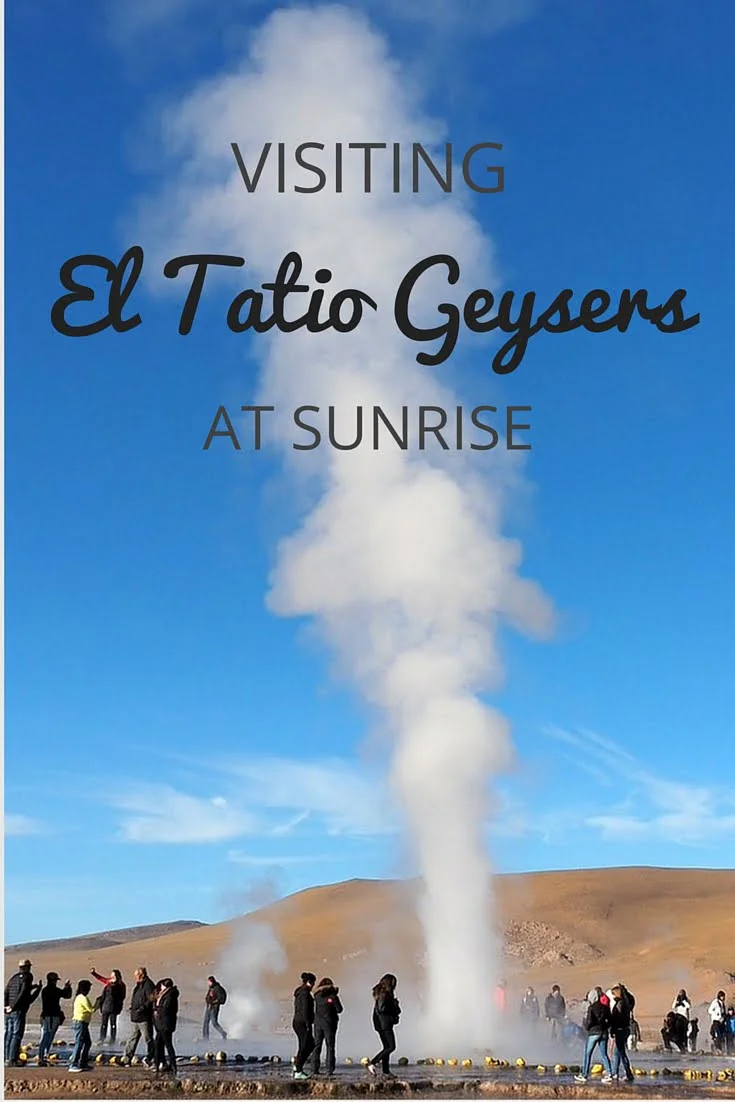
El Tatio Sunrise Planner: Everything You Need to Know (and a Little More!)
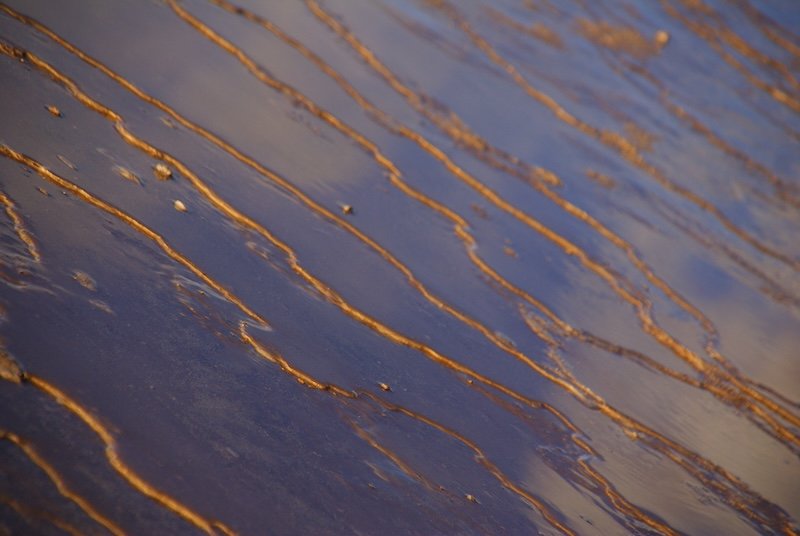
Why Sunrise Is the Sweet Spot
El Tatio sits at 4,320 m (14,173 ft). Its where dawn temps flirt with freezing while vents and fumaroles pulse with heat. That dramatic temperature contrast is why sunrise is the star of the show: cooler air + hot steam = towering plumes and an almost theatrical scene. Go later and you’ll still get geysers, but you’ll lose the height and drama of those early-morning steam columns.
- Best light: From first glow until ~45 minutes after sunrise.
- Biggest plumes: Right around sunrise, while air is coldest.
- Bonus: After the sun clears the ridges, you get easier shooting (less contrast) and warmer fingers.
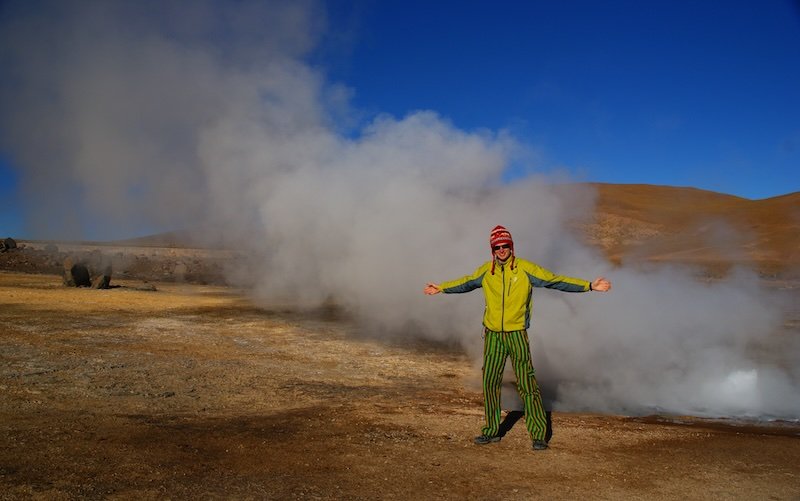
How to Visit: Tour vs. DIY (What Fits Your Travel Style?)
| Option | Best For | What’s Included | Pros | Cons |
|---|---|---|---|---|
| Small-Group Tour | First-timers, social travelers | Transport, guide, basic breakfast (some go gourmet!), park logistics | Stress-free, guides know the safe paths and best angles | Fixed timelines, more people at each stop |
| Private Tour | Photographers, families, slow travelers | Everything above, plus schedule flexibility | Customize pace, linger longer, fewer crowd bottlenecks | Higher price point; book ahead |
| Self-Drive | Confident drivers comfortable with altitude & unpaved roads | Vehicle rental, your snacks/gear | Full control over timing and stops | Pre-dawn driving in cold; verify road/park hours; watch fuel |
Sample Sunrise Timeline (What Your Morning Might Look Like)
- 04:30–05:00 – Pickup in San Pedro de Atacama (or wheels rolling if self-driving).
- 05:00–06:00 – Drive to the field (nap + blanket time).
- ~06:15 – Park entry + brief safety talk.
- 06:20–07:15 – Sunrise walk among fumaroles and geysers (aka “where you turn into an enthusiastic puff of steam yourself”).
- 07:15–08:00 – Hot spring dip (optional) + breakfast (pancakes if you luck out!).
- 08:15–10:30 – Scenic stops on the way back (wetlands, canyons, wildlife).
- 11:00–12:00 – Return to San Pedro (layers off, appetite back on).
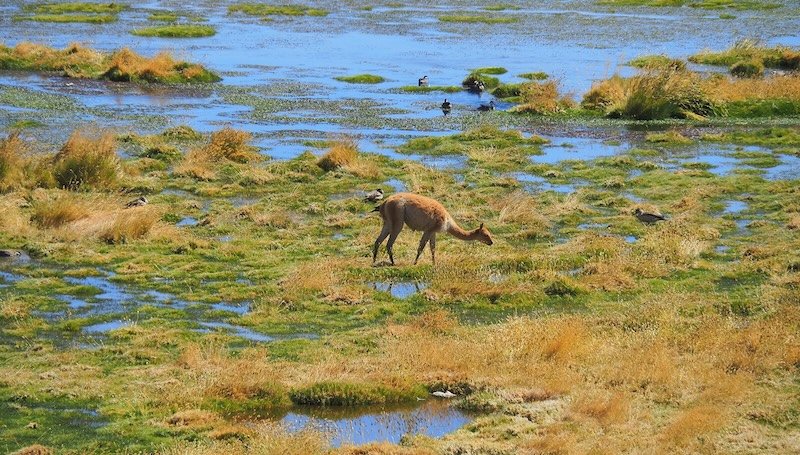
What to Pack: The Do-Not-Forget Lists
Cold-Dawn Essentials
- Insulated jacket (down or synthetic) + windproof shell
- Thermal base layer (top & bottoms)
- Warm hat + buff/neck gaiter (great sand shield)
- Gloves (liner gloves are better than numb fingers)
- Wool socks + closed shoes with grip
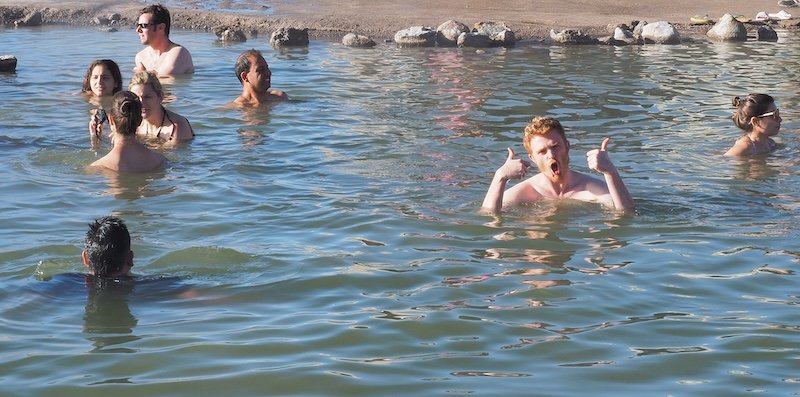
Desert & Hot Springs Kit
- Swimsuit + compact towel (microfiber dries fast)
- Flip-flops or slip-ons for the pool edge (ground is cold!)
- 1–1.5 L water per person (minimum)
- SPF sunscreen + lip balm with SPF (yes, even at dawn)
- Sunglasses (once sun is up)
Nice-to-Haves
- Headlamp (for pre-dawn walking and the change rooms)
- Snacks (salty is your friend at altitude)
- Hand warmers (pocket miracles)
- Small first-aid kit (basic meds, blister care)
- Cash (tips, park odds and ends)
Photo/Video (Keep It Light)
- One versatile lens (24–70mm does it all)
- Extra battery (cold eats charge) & microfiber cloth
- Mini tripod (for steam + silhouettes)
- Phone with RAW/HDR enabled (great backup)
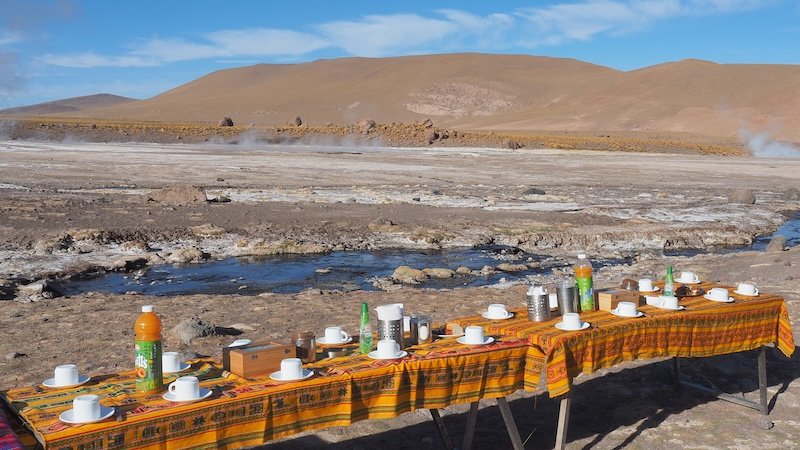
What to Wear by Season (Atacama Style, Layered)
- Summer (Dec–Feb): Cold dawn → mild morning. Thermals + fleece + shell, lightweight pants (you can peel layers by the drive back).
- Shoulder (Mar–May & Sep–Nov): Similar to summer, slightly cooler mornings; keep the wind layer handy.
- Winter (Jun–Aug): Coldest pre-dawn. Thermals + midlayer + puffy + shell, warm beanie, proper gloves.
Altitude & Health: Feel Good at 4,320 m
You’ll likely feel short of breath sooner, and you may get a light headache. Take it easy and listen to your body.
Altitude-Savvy Habits
- Hydrate (small sips often).
- Skip booze the night before (we know, we know).
- Snack smart (bananas, nuts, crackers).
- Move slowly—no sprinting for a photo (tempting, we get it).
- Rest if woozy; tell your guide if symptoms escalate.
Mild vs. Red-Flag Symptoms
- Mild/expected: Headache, slight nausea, breathlessness on exertion.
- Red flags: Persistent vomiting, confusion, chest tightness, severe headache. If these pop up, alert your guide immediately.
Hot Spring Know-How: From Brrr to Bliss
- Change room reality: Basic. Bring your own towel and headlamp.
- “The dash”: Wear your suit under thermals; quick-change into flip-flops and walk, don’t run (stone is wet).
- Jewelry + glasses: Steam fogs everything. Leave valuables in your bag.
- Post-soak: Dry off fully and layer up fast; the air is chilly.
Safety & Etiquette in the Geyser Field
- Stay on paths—ground can be thin and brittle near vents.
- Mind the wind. A sudden gust can push hot vapor your way.
- Give vents space. Your face will thank you.
- Respect quiet hours. This is nature’s show, not a stadium.
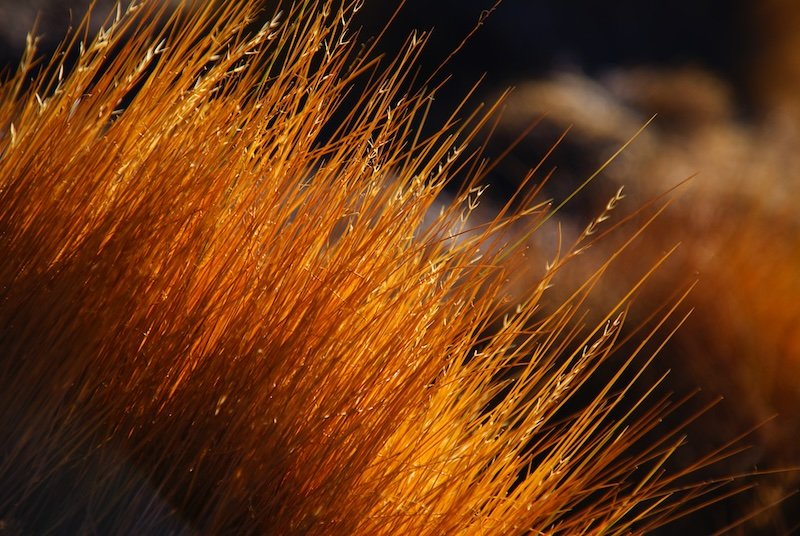
Photography Tips: Steam, Sun, and Silhouettes
Timing & Angles
- Backlight the steam at sunrise for dramatic columns.
- Side-light for textures on mineral crusts and ripples.
- Include scale—a (distant) human or a tripod shape adds impact.
Phone Settings
- Turn on grid.
- Tap to expose for highlights (steam edge).
- Use HDR or RAW if available.
- Prop your phone on a rock for sharp low-light shots.
Camera Settings (Starting Points)
- Golden hour: ISO 100–200, f/8–f/11, adjust shutter to taste.
- Blue hour/steam silhouettes: Tripod, ISO 200–400, f/4–f/5.6, 1/30–1/125s.
- Anti-fog care: Keep gear bag closed until ready; warm it gradually after the cold.
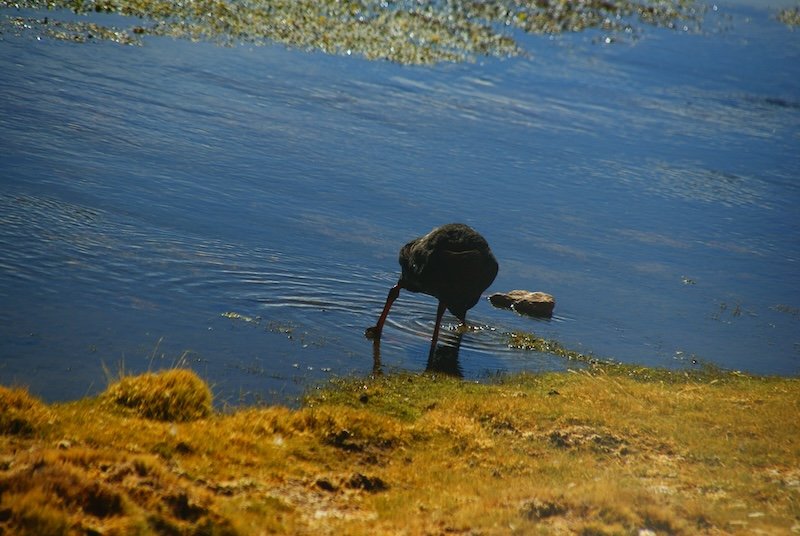
Wildlife & Landscapes on the Way Back (Keep Your Eyes Peeled)
- Vicuñas & guanacos grazing the wetlands.
- Andean geese and small waders along streams.
- Putana Volcano looming like a postcard backdrop.
- Green ribbons of vegetation along canyon trickles—little oases in a moon-scape.
Responsible Travel: Leave No Trace in the Altiplano
- Pack out everything—even tiny wrappers.
- Stay on durable surfaces (no crust-crunching).
- No drones (protected area; wildlife spook easily).
- Keep quiet near wildlife and other visitors.
- Take only photos (salt crystals are not souvenirs, tempting as they are).
Pair It With: Build a Dream Atacama Day or Two
- Sunrise El Tatio + Sunset Valle de la Luna: Classic double-hitter (nap in between is non-negotiable).
- Lagoons Day: Laguna Cejar or Baltinache float in the morning, easy afternoon, then a low-key dinner.
- Culture & Viewpoints: Quitor Pukará, Tulor Village, stroll San Pedro’s adobe lanes and cafes.
Budget Snapshot (Per Person, Rough Ranges)
- Small-group tour: $$ (transport, guide, simple breakfast; gourmet costs a touch more)
- Private tour: $$$–$$$$ (flexible timing, fewer people)
- Self-drive: $$ (rental + fuel + park entry + your snacks)
- Extras: Towel, tips, post-tour second breakfast (highly recommended)
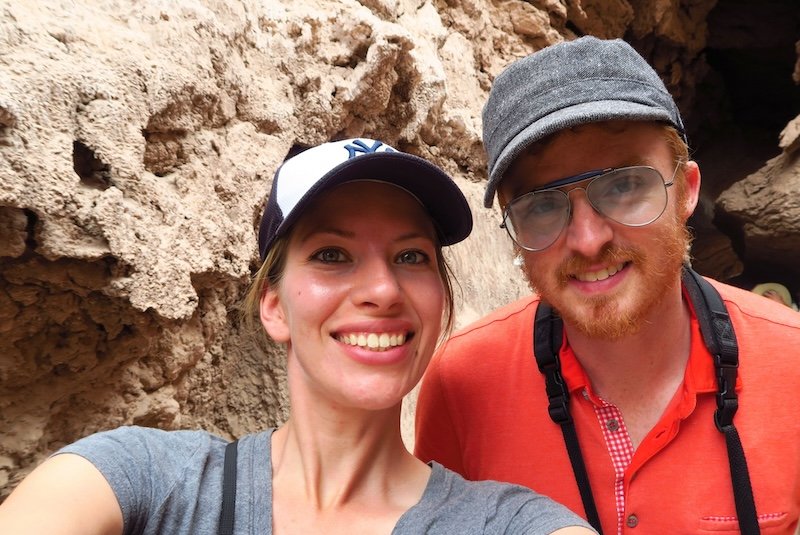
El Tatio Geysers Trip: FAQ
How cold is it at sunrise?
Expect it to hover around freezing at dawn, even in summer. With wind chill, it can feel colder. Dress in layers and keep a warm hat and gloves handy.
Do I need to acclimatize before visiting?
If you’ve just arrived in San Pedro, you may feel the altitude more. A day or two in town (2,400 m) helps. Hydrate, avoid alcohol the night before, and take it slow at the field.
Can I swim in the hot springs and still stay warm?
Yes—if you plan the transitions. Wear your suit under layers, bring a microfiber towel, and bundle up immediately after your soak. Flip-flops spare your feet from the cold stone.
Is the geyser field safe to walk around?
Yes, on marked paths. The ground near vents is fragile and sometimes thin. Follow your guide’s route and don’t cross safety ropes for a selfie.
Are drones allowed at El Tatio?
No. Drones are typically prohibited to protect wildlife and ensure visitor safety. Rangers do patrol.
What kind of breakfast should I expect?
Tours vary. Some offer simple coffee/tea + bread, others go all in with pancakes and grilled sandwiches. If breakfast matters to you (we get it!), ask your operator in advance.
Can I do El Tatio by myself without a tour?
You can, provided you’re comfortable driving pre-dawn on cold, potentially frosty roads and you’ve confirmed park hours. Bring extra water, warm layers, lights, and a full tank.
What footwear is best for the geyser field?
Closed shoes with decent grip (trail runners or light hikers). The ground is uneven, sometimes damp/icy. Save the sandals for the hot springs edge.
Will my camera fog up or get damaged by steam?
It can. Keep gear tucked away until ready, avoid breathing onto cold glass, and wipe gently with a microfiber cloth. Don’t lean into vents—mineral-laden steam isn’t camera-friendly.
What wildlife might I see on the way back?
Common sightings include vicuñas/guanacos, Andean geese, and small wading birds along wetlands. Morning light is beautiful for wildlife—give them space.
Is there anywhere to buy food or water near El Tatio?
Treat the field as bring-everything-you-need country. Tours provide breakfast; otherwise pack your own. You’ll find shops and cafes back in San Pedro.
What else should I combine with El Tatio on the same day?
Keep it light: a leisurely lunch, a siesta, and maybe a short town stroll or sunset viewpoint. If you want a big double-feature, pair it with Valley of the Moon sunset—just rest in between.
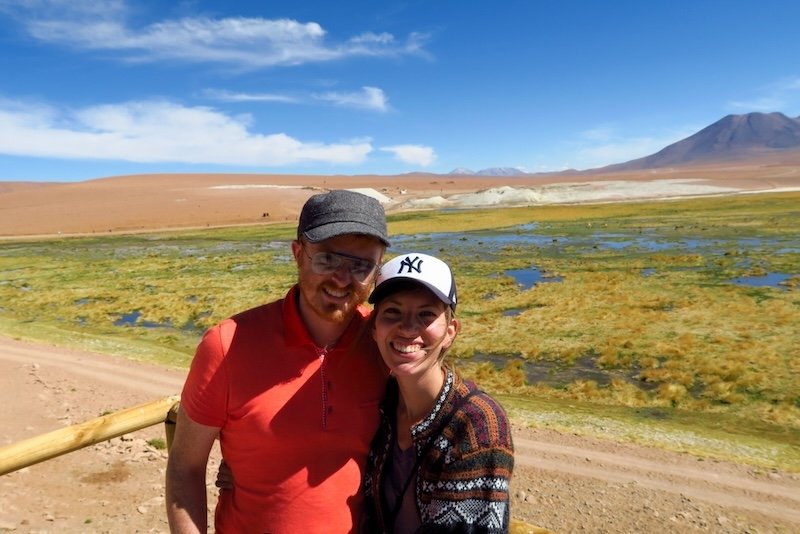
Have you visited El Tatio Geysers?
Are there any other trips around the Atacama Desert you’d recommend?

How cool! I’ve never heard of these geysers, but adding them to my travel list here in South America! I would probably not want to get unbundled to get in the hot springs either! Great pictures.
It’s a beautiful place, I made a motorhome trip through the Atacama Desert and it was awesome! If you want to travel to Chile, I recommend you rent a camper or motorhome in AndesCampers, a very friendly company, and they have a lot of different routes in their website!
So cool! I will be in Chile around July so will definitely try to go here. Worth the early rise for sure!
Which tour come did you use? I cannot see this in your blog. Thanks